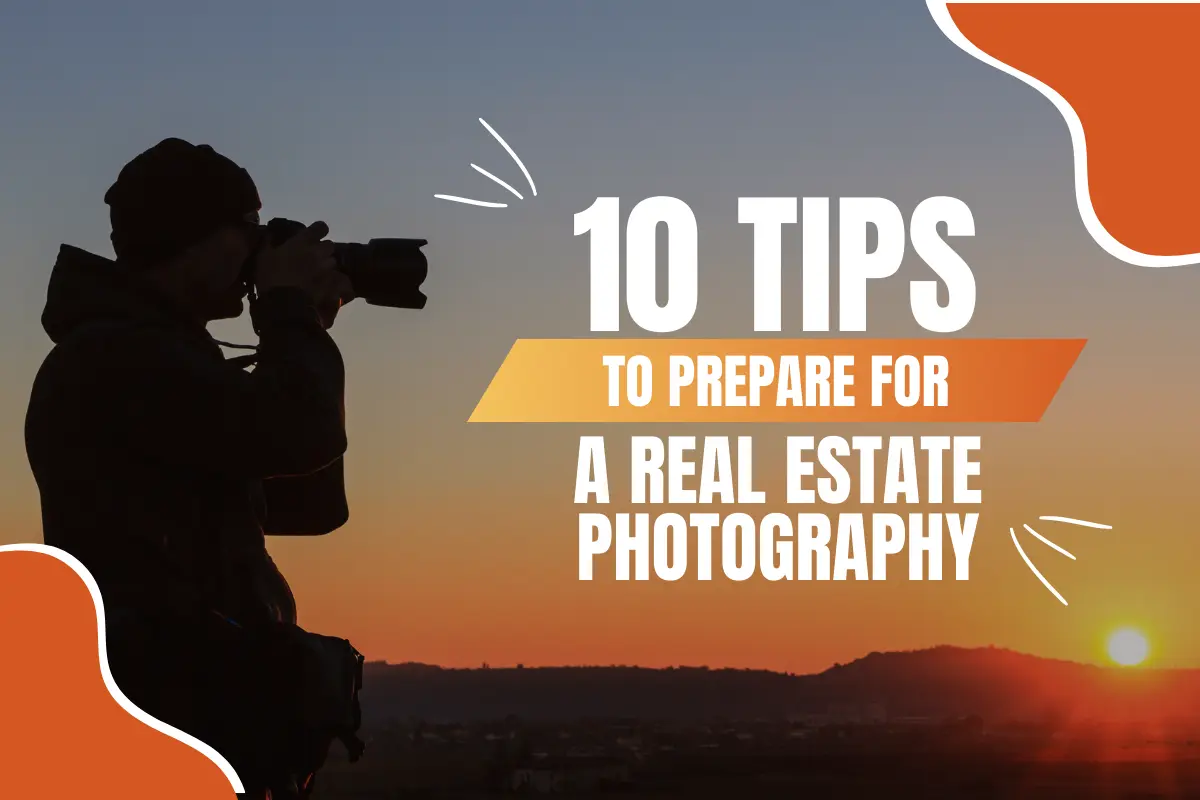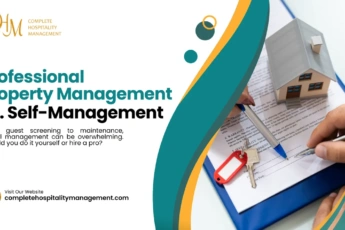10 Tips on How to Prepare Your Property for a Professional Real Estate Photography in 2025
Whether you are selling or renting a property, professional real estate photography is crucial to attracting potential clients. The photos must be attractive and give a positive impression of your property. Quality photos are the key to increasing your booking rate dramatically.
According to a 2012 study by the Behavioral and Experimental Institute of Real Estate, people interested in a property listing spend 60% of time looking at the images and 20% reading the description. For this, preparing your property before a photography session is important.

10 tips to properly prepare for a professional real estate photography
Importance of professional real estate photography
In the context of a real estate sale, the quality of the listing is essential. Whether it is the description of the property or the photographs taken and published, everything must be optimized!
- Beautiful images offer potential clients the possibility of projecting themselves, of having a more precise idea of what they can get involved in. They make it possible to highlight the strengths of the accommodation;
- 95% of people spend 20 seconds looking at the first image before deciding whether or not to continue to inquire about buying or booking;
- A picture is worth a thousand words. Prefer beautiful clear, sharp photos taken by a professional rather than dull and dark photos, which absolutely do not make you want to!
- It is possible to slightly retouch your photographs provided you do not abuse them and above all, to let your customers know!
Only few options are then available to clients. If the images attract them, they will be more likely to contact the real estate agent, come and visit the property or book/but it. Otherwise, the number of requests for this same property could be quite low.
Why a professional photographer for real estate photos is a must
Some real estate agencies take care of their own photos. Others prefer to go through a professional photographer to take nice indoor and outdoor photos of the property concerned. This is due to several reasons:
- A professional photographer has the skills and equipment to take quality photos that will highlight the property’s strengths and grab the attention of potential clients;
- They know the best shooting and image editing techniques to showcase real estate, which can help create attractive and compelling photos.
- Finally, a pro photographer can also advise the real estate agent on presenting the photos to maximize their impact and entice potential customers to learn more about the property.
Overall, a pro photographer brings expertise, technical skill, and artistic vision to capture your property’s best features. Investing in professional real estate photography is a must to make a strong first impression, attract potential buyers, and ultimately increase your chances of a successful sale.
For what you can use professional
real estate photography
Professional real estate photography can be used for various purposes and benefit different individuals and entities in the real estate industry. Here are common uses of professional real estate photography:
- Property listings. Agents and property owners can use high-quality images to showcase properties in online listings, brochures, and other marketing materials. These pics help attract potential clients and create a good first impression.
- Advertising and marketing. Real estate developers, property management companies, and agencies use pro photography to promote their services, portfolios, and expertise. These visuals can be used in ads, social media campaigns, websites, etc.
- Virtual tours. Photos can be used to create virtual tours of properties, allowing potential buyers to explore the space remotely. Virtual tours provide a more immersive and interactive experience, giving viewers a better sense of the property’s layout, features, and ambiance.
- Print media. High-quality photographs, including real estate magazines, newspapers, and promotional materials, are essential for print media. These visuals enhance the property’s overall presentation, capturing potential clients’ attention and increasing the chances of a successful deal.
- Investor presentations. Real estate developers and property owners often use pro photography to create visually compelling presentations for potential investors. These visuals help convey the value of the property, making it more appealing to investors.
- Real estate websites and portals. Platforms like Airbnb, Vrbo, Booking.com rely heavily on visual content to attract users. Pro real estate shoot helps improve the overall visual appeal of the website and increase user engagement.
Pro real estate photography is a valuable tool for creating a strong visual presence, attracting potential clients, and increasing the marketability of properties. Its applications extend beyond property listings and can benefit various aspects of the real estate industry.
10 tips to properly prepare for a professional
real estate photography
Remember that 83% of people consider photos as essential listing elements. So that, preparing your property well before a real estate photography session is crucial. Here are some practical tips to help you.

2 facts about a professional photos for listings
1. Clean and tidy your property
The first step to a successful real estate photography session is cleaning and tidying up your property. You want your property to look presentable and welcoming to potential customers.
Be sure to clean every room, especially common areas such as the kitchen and bathroom. Also, store personal items such as family photos and trinkets to give your property a more neutral and impersonal look.
2. Make minor repairs if needed
Before the real estate photography session, take the time to make minor repairs to your property that are nevertheless visible! For example, a wall with crumbled paint, stains on the floors, replacing or repairing broken objects, etc. Here are more points:
- Fix loose or wobbly items.
- Patch wall holes.
- Repair damaged paint.
- Fix broken light fixtures.
- Repair or replace broken windows.
- Fix leaky faucets.
- Repair damaged flooring.
- Tighten loose handles.
- Replace burnt-out bulbs.
- Repair or replace damaged doors.
These repairs will help ensure that your property looks well-maintained and appealing in the real estate photography.
3. Clear out storage spaces in your property
Potential customers will likely be interested in storage spaces such as closets and cabinets. Make sure these spaces are tidy and clear. Potential customers will thus be able to visualize their own storage in these spaces better.
4. Light up your property well
Light is a crucial element for a real estate photography. Ensure your property is well-lit by opening curtains and blinds to let in natural light. If it lacks natural light, use artificial lights. Here are some other tips:
- Open curtains and blinds. Allow natural light to fill the space by opening curtains and blinds fully. Natural light creates a welcoming and bright atmosphere.
- Replace burnt-out bulbs. Check all light fixtures and replace any burnt-out bulbs. Opt for bulbs with appropriate wattage to ensure sufficient brightness in each room.
- Clean light fixtures. Dust and clean light fixtures to maximize their brightness. Clean fixtures can help distribute light evenly and prevent any dimness caused by dirt or debris.
- Use multiple light sources. Combine different light sources, such as ceiling, table, floor, and wall sconces, to provide balanced and layered lighting throughout the property.
- Consider daylight bulbs. Choose daylight bulbs or ones with a color temperature between 5000K and 6500K. They simulate natural daylight, providing photos with a clean and bright appearance.
- Utilize ambient and task lighting. Use a combination of ambient lighting (overhead or general lighting) and task lighting (reading lamps or desk lamps) to create a well-lit and functional space.
- Check light switch placement. Ensure they are easily accessible and located near the entrance of each room. This allows photographers to turn on/off lights during the session quickly.
- Remove heavy window treatments. If they block natural light, consider removing them temporarily to maximize the room’s light.
- Use reflectors or bounce boards. If certain areas are too dimly lit, use them to redirect and amplify natural or artificial light towards darker spots, creating a more balanced lighting setup.
- Test lighting before the photography session. Walk through each room and assess the lighting quality. Adjust the placement of lamps, modify blinds for optimal natural light, and make any necessary changes.
By following these tips, you can ensure that your property is well-lit and presents in its best light during the real estate photography session, creating attractive and inviting visuals.
5. Highlight the assets of your real estate
Each property has unique assets. Highlight them by presenting well during the real estate photography session. If your property has an unobstructed view, make sure the photos show that view. If your property has a fireplace or a large deck, showcase it to show off your property’s potential.
6. Depersonalize your accommodation
When preparing your property for a real estate photography, depersonalize it as much as possible. Remove personal items such as family photos, movie posters, or sports trophies. This will allow potential customers to imagine themselves better living in your property.
- Remove personal photos and memorabilia.
- Clear personal items from surfaces and declutter.
- Neutralize artwork and decor.
- Hide personal information and documents.
- Depersonalize children’s rooms.
- Replace personalized bedding and linens.
The goal is to create a blank canvas that allows potential clients to imagine themselves living in the space. Depersonalization can help prospective customers visualize their own lives in the property during the real estate photography session.
7. Do not show your animals in photos
Even if you’re proud of your pet, it’s best if they don’t show up in your photos. Animals can distract potential customers; some might have allergies or don’t like animals. Exception, on the other hand, if the property is shared and the animals will be present in the common places during the visit of the tenants (they should be warned!)
8. Add decorative elements in the rooms
Although you should depersonalize your property, that doesn’t mean you should leave the walls blank. Add some decorative touches to make your property more attractive. Colorful throw pillows on the sofa or a green plant in the corner can bring your property to life.
Top 10 decorative additions for eye-catching property shots
| Element | Clarification |
|---|---|
| Fresh flowers or plants | Adds a touch of natural beauty and freshness |
| Neutral artwork or mirrors | Enhances visual interest and creates the illusion of space |
| Decorative throw pillows | Adds pops of color and texture, creating a cozy atmosphere |
| Coordinated curtains or blinds | Enhances natural light and creates a cohesive look |
| Stylish rugs | Defines spaces and adds warmth and texture |
| Well-staged table settings | Creates an inviting and elegant dining area |
| Ambient lighting | Adds warm and inviting lighting conditions |
| Decorative accessories | Adds visual interest to shelves, tables, or mantels |
| Coordinated bedding and linens | Creates a comfortable and inviting bedroom |
| Stylish and organized shelves | Adds depth and character to the room |
9. Pay special attention to details
Details can make all the difference in real estate photography. Ensure bed sheets are tight and towels are neatly folded in the bathroom. Remove exposed electrical cables and wires to give a clean and professional appearance.
10. Ask a friend for advice
Before the photography, seek the advice of a friend or family member. Ask them to put themselves in the shoes of a potential client and give you their opinion on the presentation of your property. This can help you spot things you might have missed and improve the presentation of your property for the real estate photography session.
The need for photo retouching
for a real estate listing
It can be helpful to retouch photos in listings sometimes, but it is essential to do so reasonably and transparently. Image editing can be used to correct minor imperfections in photos to make them more attractive:
- reflections or shadows;
- brightness improvement;
- colors adjustments.
This can help highlight the property’s strengths and grab potential clients’ attention. But overdoing can mislead potential clients and lead to selling problems. Clearly state in the listing if the photos have been retouched so potential customers know what to expect when viewing the property.
What software to use to retouch real estate photos
Several software programs can be used to edit real estate photos. The most common are image editing software such as Photoshop or GIMP, which offer a wide range of tools to correct imperfections and improve the quality of photos. More tools you can find below.
Top software options for real Estate photo editing
| Software | Description | Price |
|---|---|---|
| Adobe Photoshop | Powerful photo editing software with extensive features | Subscription |
| Adobe Lightroom | Image editing and organizing software for photographers | Subscription |
| Capture One Pro | Professional editing software with advanced tools | Subscription |
| DxO PhotoLab | RAW photo editing software with noise-reduction capabilities | Subscription |
| Skylum Luminar | AI-powered photo editing software with various presets | One-time purchase |
| ON1 Photo RAW | Comprehensive photo editing suite with RAW processing | Subscription |
| GIMP | Free and open-source image editing software | Free |
| Corel PaintShop Pro | Photo editing software with a range of creative tools | One-time purchase |
| Affinity Photo | Professional photo editing software with non-destructive editing | One-time purchase |
| Photomatix Pro | HDR imaging software for blending multiple exposures | One-time purchase |
This software can also add effects or filters to highlight the property’s pros or create attractive compositions. It is also possible to use video editing software to create immersive videos of the good, using transitions and effects to create fluid and coherent experience. Please note that all information above is subject to change.
As a conclusion
By following these 10 simple tips, you can prepare your property for a successful professional real estate photography. Remember that quality photos can make all the difference when it comes to selling or renting your property. Book your real estate photographer now on CHM for pro images of your property.
Frequently asked questions about professional
real estate photography
1. What is a real estate photography?
Real estate photography is the process of taking stunning pictures of homes with the main goal of marketing them as for sale or rent. It entails taking pictures of several kinds of real estate, including vacant land, apartments, condos, and residential and commercial buildings.
Real estate photography is to present the property in the most desirable manner to potential clients. Aiming to showcase the property’s distinctive selling aspects, skilled photographers utilize professional tools and techniques to capture the property’s important features.
2. What is the objective of real estate photography?
Real estate photography’s goal is to present a property in the most alluring and interesting light possible. Real estate photography of the highest caliber aims to elicit an emotional response and foster a favorable first impression, ultimately assisting in the sale or leasing process.
3. How do I edit real estate photos like a pro?
To edit real estate photos like a professional, you can follow these steps:
- Use RAW format. Shoot in this format rather than JPEG to have more flexibility and control over the editing process.
- Straighten and crop. Correct any tilted or crooked angles. Then, crop the photo to enhance composition and remove any distracting elements.
- Adjust white balance and exposure to ensure accurate colors and to balance the brightness and darkness of the image, making sure details are visible in both the highlights and shadows.
- Enhance colors and contrast. Making the image more appealing requires adjusting the saturation and vibrance. To enhance depth and make the picture stand out, boost the contrast.
- Correct lens distortion. Especially when utilizing wide-angle lenses, lens distortion in real estate photography is frequently beneficial to be corrected. To make lines straighter and reduce distortion, use lens correction tools.
- Remove distractions. Remove any undesirable elements, such as dust, stains, or individual items that can distract from the property’s beauty using the clone stamp or healing brush tool.
- Enhance details. To highlight features, sharpen the image, but avoid going overboard. To enhance textures and give the image a more defined, crisp appearance, adjust the clarity or structure.
- Brighten interiors. Brightening is frequently needed in real estate interiors to highlight the space. To boost the lighting overall and to lighten dark regions, use selective editing techniques like dodging and burning.
- Keep it natural. Avoid excessive saturation, overly HDR-like effects, or heavy-handed editing that distorts the true representation of the property.
- Consistency. Maintain a consistent editing style throughout your real estate photos to create a cohesive and professional portfolio.
Practice is key to refining your editing skills. Experiment with different techniques, study professional real estate photography portfolios for inspiration, and strive to develop your own unique editing style.
4. How do estate agents take photos?
Estate agents, or real estate agents, often take property photos themselves to showcase listings. While they may not have the same level of expertise as professional photographers, they can still take appealing photos using the following tips:
- Prepare the property;
- Use a good camera;
- Natural lighting is key;
- Capture key features;
- Use wide-angle lens;
- Composition and framing;
- Declutter and stage;
- Exterior shots;
- Edit and enhance;
- Upload to online platforms.
While estate agents may not achieve the same level of expertise as pro photographers, following these tips can help them capture decent property photos that effectively showcase listings and attract potential buyers or tenants.
5. What is the best order for real estate photos?
When presenting real estate photos, the order should be structured in a way that engages potential buyers and highlights the property’s best features. While there isn’t a fixed formula, here’s a suggested order that often works well:
- Exterior front shot. Begin with a high-quality photo of the front of the property, showcasing its curb appeal and creating a positive first impression.
- Living spaces. Proceed with interior shots of the main living areas, such as the living room, dining room, and family room. Take pictures of these areas from various perspectives to help viewers understand the layout and possible furniture arrangements.
- Kitchen. Highlight the kitchen because it is frequently a key selling point. Take pictures of the countertops, appliances, and any distinctive features from both a wide angle and up close.
- Bedrooms. Include the bedrooms, beginning with the master bedroom and moving on to any more bedrooms that might be appropriate. Display the room’s size, amount of natural light, and any unique features, such as walk-in closets or en suite bathrooms.
- Bathrooms. Include the master bathroom and any more bathrooms in the list of bathrooms. Pay close attention to the hardware, decor, and any unique features like spa tubs or specialty showers.
- Outdoor spaces. Showcase any outdoor areas like patios, decks, gardens, or swimming pools. Emphasize the potential for relaxation, entertainment, or outdoor dining.
- Unique features. If the property has any unique or standout features such as a home office, media room, wine cellar, or gym, include dedicated photos to highlight these spaces.
- Additional rooms. Include photos of any other rooms like a home gym, study, playroom, or den. These can be placed after the main living areas and bedrooms.
- Storage areas. Capture shots of storage areas such as closets, pantries, and garages. Buyers are often interested in available storage space.
- Landscaping and views. Finish with photos that showcase the property’s landscaping, gardens, and any noteworthy views from windows or balconies. These photos can leave a lasting impression.
Always use high-resolution, well-lit, and correctly composed photographs. To improve the viewing experience, think about arranging the photographs in a gallery arrangement or as a slideshow that is visually appealing.
6. Do estate agents charge for photos?
Different real estate agents may have different fee rules. While some agents may charge extra or make it an optional add-on, others might include pro photos as part of their services. It is best to inquire about the agent’s specific policies.
7. How high should camera be for real estate photography?
The camera height or angle must be carefully considered while taking real estate photos in order to portray the property in the most attractive and informative light. The following general recommendations for camera height:
- Eye-Level. Shooting from eye level or just above eye level is generally a good place to start. This perspective serves to give a realistic impression and enables viewers to see themselves using the area.
- Chest-Level. Lowering the camera to chest level can be beneficial depending on the room or place you are photography, particularly for capturing areas like kitchens or countertops. The details can be highlighted and the room can appear larger from this perspective.
- Waist-Level. To photograph restrooms or smaller rooms, you can lower the camera to about waist level or slightly lower. This perspective can add a sense of depth while highlighting the fixtures and fittings.
- Elevated views. Some situations may benefit from using a higher vantage point, especially when taking wide outdoor pictures or displaying a property’s layout. A drone, a tripod with a movable center column, or taking the photo from a higher level or balcony can all be used to accomplish this.
Try out different camera heights and angles to emphasize the property’s attractions to the best of your ability. Vertical lines must remain straight to avoid distortion, particularly when photographing from low angles. Real estate photography can also be made better by using a wide-angle lens and good lighting.
8. Should you use a flash for real estate photography?
Although it is not always necessary, using a flash for real estate photography may be useful in some situations. To help you decide whether to employ a flash, consider the following factors:
- Natural light. It makes the environment more welcoming and authentic, enabling potential buyers to view the house as it actually is. Additionally, it lessens harsh shadows and artificial-looking lighting while preserving realistic color.
- Ambient light. Evaluate the property’s current lighting setup. You might not need to utilize a flash if there is enough light coming from windows, skylights, or well-lit interior locations. A more natural and pleasing appearance can be achieved by utilizing current light sources.
- Low light situations. Flashes have their uses. The scene is more uniformly lit, making it easier to see details and ensuring that the picture is properly exposed. Nevertheless, it’s crucial to utilize the flash sparingly to prevent overexposing the subject or producing harsh lighting that seems unnatural.
- Balanced lighting. When taking pictures of interiors with big windows or places, it is useful. Combining a flash with existing or natural illumination as fill light can assist balance the exposure and reduce stark contrast.
- Bracketing or HDR. To create a final image, it includes taking many exposures at various settings and blending them together in post-processing. In both bright and gloomy situations, it can effectively capture a larger range of light while preserving detail.
In real estate photography, the decision to use a flash ultimately depends on the specific lighting conditions and the desired outcomes. The idea is to capture the home in the best possible light while accurately capturing all of its aspects.
9. What are the dimensions for real estate photography?
Real estate images may not have standard dimensions that apply to all platforms or usage. The following, however, are some established standards for image dimensions:
- Aspect ratio. The aspect ratio that is most frequently utilized for real estate photography is 3:2, which offers a balanced and organic appearance. This indicates that the image’s width is 1.5 times its height.
- Resolution. To show off the property in detail, take and display high-resolution real estate images. For online platforms and print products, a resolution of 3000 pixels on the longest side or higher is typically acceptable.
- Website requirements. They frequently have recommended dimensions or particular size restrictions. For the best image display, it’s crucial to review the platform’s rules or suggestions.
- Print materials. Higher resolution and larger image dimensions are often required if you intend to use the photos for brochures or flyers. For information on the precise requirements, speak with the printer or the designer.
- Flexible cropping. Such photographs might need to be cropped or downsized. To allow for flexibility in cropping and framing, it’s beneficial to take pictures of subjects with a little bit of extra space around them.
Although these suggestions may be helpful, consider the specific requirements of the platform or media where the photographs will be used. Following those recommendations will make sure that your real estate images are presented ideally and highlight the best features of the property.
10. What ratio is best for real estate photography?
Real estate photography should use the 3:2 aspect ratio, which is both popular and advised. The breadth of the image is 1.5 times the height, creating a harmonious and organic appearance. It is appropriate for a variety of venues, including print products and internet.
Updated on: . Author:






